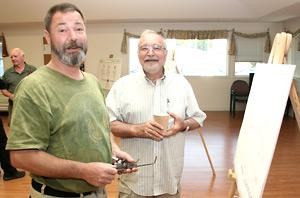Residents were provided with the opportunity to find out more about the City of Powell River’s liquid waste management plans and talk to council and staff about the ramifications.
At a town hall meeting held at Cranberry Seniors’ Centre, Monday, June 15, a series of charts were displayed to outline the history and current initiatives being taken to replace the city’s three treatment plants with a consolidated standalone facility.
Councillor Karen Skadsheim, chair of the city’s liquid waste management steering committee, said the liquid waste management project has been a long time coming.
“I’ve been told it’s only second to the Capital Regional District’s sewage treatment process as far as time goes,” she said. “I’m pretty pleased that we are finally able to move forward with our own standalone, publicly owned and operated facility.”
Skadsheim said long before seeking public office, she had been fighting against co-treatment of liquid waste in conjunction with Catalyst Paper Corporation. She was pleased that city council supported getting rid of the co-treatment option and the risks involved with that, moving forward instead with a much simpler standalone facility, which, in her view, will be less costly in the long run.
Skadsheim said the provincial ministry of environment has accepted the city’s phase three liquid waste plan. To that end, city representatives have requested a meeting with the provincial minister of environment at the Union of BC Municipalities annual convention in September to discuss moving forward with liquid waste management in Powell River.
Approval of the plan is expected late this year or early next year. Skadsheim’s hope is that the city will be ready to issue requests for proposals early next spring.
When city council adopted a motion to move forward with this plan, the premise was to have a facility that is environmentally and technologically innovative.
“I think that will definitely be in our request for proposals,” Skadsheim said. “There’s a lot of really interesting technologies out there for sewage treatment. Given the planned location of the plant, right on the foreshore in Townsite, we have to be diligent.”
Tor Birtig, the city’s director of infrastructure, said the purpose of the town hall meeting was to let residents know what council’s decision was regarding the phase three liquid waste management plan.
“What council has decided is that a consolidated plant will handle sewage from Townsite and Westview, as well as the lagoon in Wildwood, in the future,” he said.
The new treatment plant would be located in Townsite in the vicinity of the city’s existing treatment facility there.
Once the city has received approval from the ministry of environment on its phase three plan, there will be a discussion about what kind of treatment can be provided at the new plant. Once that has been approved the city will go to final design. At that point the city will be ready for grant funding applications.
“Our estimation is we are seven to 10 years out,” Birtig said, regarding completion of the new treatment plant.
If the city was hypothetically to submit its final design today, there are no senior government grants available to assist the community with funding the project. The estimate for a standard standalone treatment facility in Townsite is $25 million. Birtig said if the city was to look more toward innovative treatment options, then that price could go up, but there is the possibility of some monetary recovery. Sechelt used innovative technology in its new treatment plant and Birtig believes the community secured a grant that paid for 50 per cent of the cost. He believes that particular plant cost $20 million, serving a smaller population than Powell River’s.
Construction of a new liquid waste treatment plant would be one of the biggest projects initiated by the city. Birtig said if the city had to pay for the whole project, the annual taxation cost of the project to the average taxpayer would be about $60.
The treated water coming out of the new plant will have to meet or exceed both provincial and federal regulations, which are considerably more stringent than the permits the current treatment plants are operating under.



